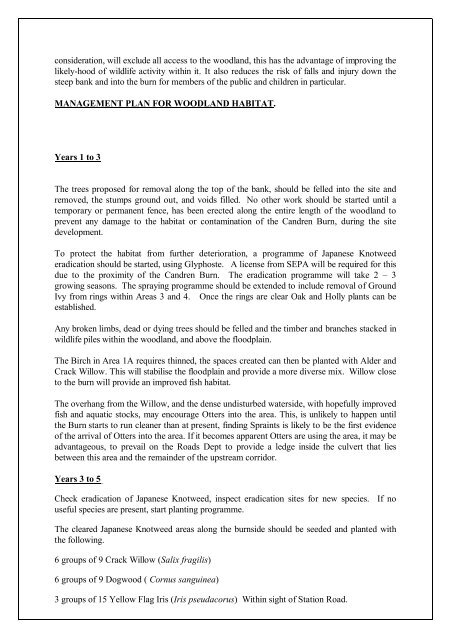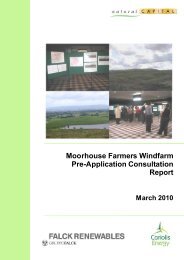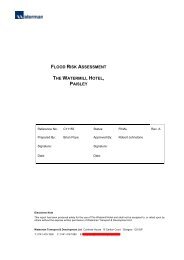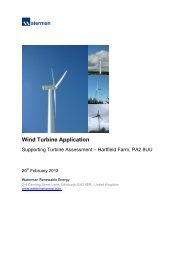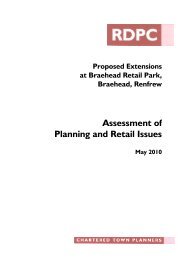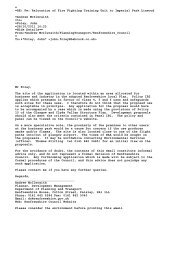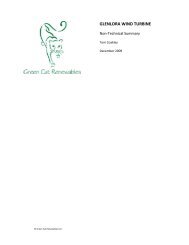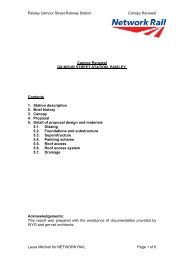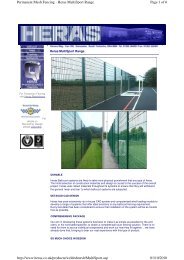WOODLAND and HABITAT PLAN CANDREN BURN, MILLARSTON ...
WOODLAND and HABITAT PLAN CANDREN BURN, MILLARSTON ...
WOODLAND and HABITAT PLAN CANDREN BURN, MILLARSTON ...
You also want an ePaper? Increase the reach of your titles
YUMPU automatically turns print PDFs into web optimized ePapers that Google loves.
consideration, will exclude all access to the woodl<strong>and</strong>, this has the advantage of improving the<br />
likely-hood of wildlife activity within it. It also reduces the risk of falls <strong>and</strong> injury down the<br />
steep bank <strong>and</strong> into the burn for members of the public <strong>and</strong> children in particular.<br />
MANAGEMENT <strong>PLAN</strong> FOR <strong>WOODLAND</strong> <strong>HABITAT</strong>.<br />
Years 1 to 3<br />
The trees proposed for removal along the top of the bank, should be felled into the site <strong>and</strong><br />
removed, the stumps ground out, <strong>and</strong> voids filled. No other work should be started until a<br />
temporary or permanent fence, has been erected along the entire length of the woodl<strong>and</strong> to<br />
prevent any damage to the habitat or contamination of the C<strong>and</strong>ren Burn, during the site<br />
development.<br />
To protect the habitat from further deterioration, a programme of Japanese Knotweed<br />
eradication should be started, using Glyphoste. A license from SEPA will be required for this<br />
due to the proximity of the C<strong>and</strong>ren Burn. The eradication programme will take 2 – 3<br />
growing seasons. The spraying programme should be extended to include removal of Ground<br />
Ivy from rings within Areas 3 <strong>and</strong> 4. Once the rings are clear Oak <strong>and</strong> Holly plants can be<br />
established.<br />
Any broken limbs, dead or dying trees should be felled <strong>and</strong> the timber <strong>and</strong> branches stacked in<br />
wildlife piles within the woodl<strong>and</strong>, <strong>and</strong> above the floodplain.<br />
The Birch in Area 1A requires thinned, the spaces created can then be planted with Alder <strong>and</strong><br />
Crack Willow. This will stabilise the floodplain <strong>and</strong> provide a more diverse mix. Willow close<br />
to the burn will provide an improved fish habitat.<br />
The overhang from the Willow, <strong>and</strong> the dense undisturbed waterside, with hopefully improved<br />
fish <strong>and</strong> aquatic stocks, may encourage Otters into the area. This, is unlikely to happen until<br />
the Burn starts to run cleaner than at present, finding Spraints is likely to be the first evidence<br />
of the arrival of Otters into the area. If it becomes apparent Otters are using the area, it may be<br />
advantageous, to prevail on the Roads Dept to provide a ledge inside the culvert that lies<br />
between this area <strong>and</strong> the remainder of the upstream corridor.<br />
Years 3 to 5<br />
Check eradication of Japanese Knotweed, inspect eradication sites for new species. If no<br />
useful species are present, start planting programme.<br />
The cleared Japanese Knotweed areas along the burnside should be seeded <strong>and</strong> planted with<br />
the following.<br />
6 groups of 9 Crack Willow (Salix fragilis)<br />
6 groups of 9 Dogwood ( Cornus sanguinea)<br />
3 groups of 15 Yellow Flag Iris (Iris pseudacorus) Within sight of Station Road.


